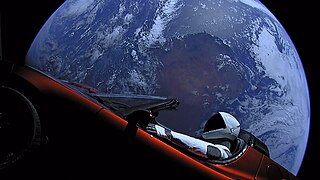Related Research Articles

A CubeSat is a class of miniaturized satellite with a form factor of 10 cm (3.9 in) cubes. CubeSats have a mass of no more than 2 kg (4.4 lb) per unit, and often use commercial off-the-shelf (COTS) components for their electronics and structure. CubeSats are put into orbit by deployers on the International Space Station, or launched as secondary payloads on a launch vehicle. As of December 2023, more than 2,300 CubeSats have been launched.

This comparison of orbital launch systems lists the attributes of all individual rocket configurations designed to reach orbit. A first list contains rockets that are operational or in development as of 2023; a second list includes all upcoming rockets and a third list includes all retired rockets For the simple list of all conventional launcher families, see: Comparison of orbital launchers families. For the list of predominantly solid-fueled orbital launch systems, see: Comparison of solid-fueled orbital launch systems.

Several new rockets and spaceports began operations in 2016.

This article compares different orbital launcher families. The article is organized into two tables: the first contains a list of currently active and under-development launcher families, while the second contains a list of retired launcher families.

This article documents notable spaceflight events during the year 2019.

Notable spaceflight activities in 2017 included the maiden orbital flight of India's Geosynchronous Satellite Launch Vehicle Mark III on 5 June and the first suborbital test of Rocket Lab's Electron rocket, inaugurating the Mahia spaceport in New Zealand. The rocket is named for its innovative Rutherford engine which feeds propellants via battery-powered electric motors instead of the usual gas generator and turbopumps.

This article documents notable spaceflight events during the year 2018. For the first time since 1990, more than 100 orbital launches were performed globally.
Technology Education Satellite (TechEdSat) is a successful nano-sat flight series conducted from the NASA Ames Research Center in collaboration with numerous universities. While one of the principal aims has been to introduce young professionals and university students to the practical realm of developing space flight hardware, considerable innovations have been introduced. In addition, this evolving flight platform has tested concepts for Low Earth Orbit (LEO) sample return, as well as planetary nano-sat class mission concepts.
SkySat is a constellation of sub-meter resolution Earth observation satellites owned by Planet Labs, providing imagery, high-definition video and analytics services. Planet acquired the satellites with their purchase of Terra Bella, a Mountain View, California-based company founded in 2009 by Dan Berkenstock, Julian Mann, John Fenwick, and Ching-Yu Hu, from Google in 2017.

Nanoracks LLC is a private in-space services company which builds space hardware and in-space repurposing tools. The company also facilitates experiments and launches of CubeSats to Low Earth Orbit.

Planet Labs PBC is a publicly held American Earth imaging company based in San Francisco, California. Their goal is to image the entirety of the Earth daily to monitor changes and pinpoint trends.

EgyptSat 2 was Egypt's second remote sensing Earth observation satellite. It was built by the Russian RSC Energia and the Egyptian NARSS while the incorporated cameras and payload was developed by OAO Peleng and NIRUP Geoinformatsionnye Sistemy in Belarus.
Tyvak Nano-Satellite Systems was an American company designing and building satellites. It started as a designer, builder and provider of nanosatellite and CubeSat space vehicle products and services for government and commercial customers. Tyvak was based in Irvine, California. It was a subsidiary of Terran Orbital Corporation. In 2022, it was announced that Tyvak would transition into larger satellites from nanosats and cubesats and the name Tyvak would be phased out in favor of the name of the parent company Terran Orbital.
NanoAvionics Corp is a small satellite bus manufacturer and mission integrator founded as a spin-off from Vilnius University, Lithuania in 2014.

Note: As of the school year of 2022, the Irvine CubeSat STEM Program has been shut down. The Irvine Public School Foundation (IPSF) has reallocated the CubeSat funding elsewhere and Brent Freeze has left the project to pursue other endeavors. This change could have resulted from the lack of productivity during the COVID-19 pandemic and the loss of talented students. It is rumored that the program could return during the 2023 school year.
Irvine CubeSat STEM Program (ICSP) is a joint educational endeavor to teach, train and inspire the next generation of STEM professionals. ICSP involves students from six high schools from Irvine, California, and its main objective is to assemble, test, and launch a CubeSat into low Earth orbit.

Kanopus-V-IK is a Russian Earth observation satellite developed by the All-Russian Scientific Research Institute of Electromechanics and operated by Roscosmos. It was launched on July 14, 2017, designed for monitoring the environment over a large swath of land, and has an expected service life of 5 years.
References
- 1 2 3 "NANOACE". tyvak.eu. Tyvak Nano-Satellite Systems, Inc. 2017. Retrieved January 29, 2024.
- 1 2 3 Krebs, Gunter (2023). "NanoACE". space.skyrocket.de. Gunter's Space Page. Retrieved January 29, 2024.
- ↑ Foust, Jeff (2017). "Soyuz Launches 73 satellites". spacenews.com. SpaceNews. Retrieved January 29, 2024.
- ↑ Burger, Edward; Bordacchini, Giulia (2019). Yearbook on Space Policy 2017. Cham, Switzerland: Springer. p. 321. ISBN 978-3-030-05417-5.
- 1 2 3 4 "NANOACE". n2yo.com. Retrieved February 2, 2024.
- 1 2 3 "NanoACE". spaceflight101.com. Spaceflight101. 2017. Retrieved February 2, 2024.
- ↑ Werner, Debra (2017). "Astro Digital announces first cubesats launched on Soyuz failed". spacenews.com. SpaceNews. Retrieved February 2, 2024.